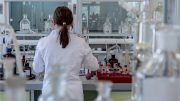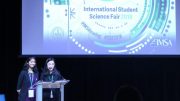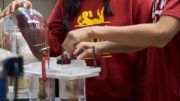Not long after the break of dawn every Wednesday, IMSA students board the bus to Chicago for their SIR project. Four of them — Daniel Chen (’19), Joanna Lee (’19), Marisa Patel-O’Conner (’19), and Tanmayee Vegesna (’19) — work with researchers at the University of Illinois in Chicago to investigate the effects of high cholesterol and obesity on wound healing. In their project, they compare genetically modified high-cholesterol mice and mice fed a high-fat diet to those that receive a normal diet. On Thursday’s annual IMSAloquium, they will be proudly showcasing the accumulation of their hard work to the rest of the student population.
Regarding the process of completing her project, Patel-O’Conner recalls the large amount of research she performed during the beginning of the school year. “The entire first semester was mainly dedicated to reading up on research papers on some of the main topics covered and overseeing our adviser’s work,” she says. All the preliminary work was in preparation for the lab skills she developed this semester. After understanding the research project, she applied the techniques to the lab setting, an experience that she considers her biggest takeaway from SIR. “At the beginning of the year, we would struggle to do the littlest things, even with our adviser hovering over us,” she says. “Now we can take a given protocol given to us and figure it out on our own.”
Vegesna has also enjoyed the rewarding process of working in a lab environment. Upon reflecting at the beginning of her SIR experience, she remembers that her project had caught her attention for having “most biology.” She appreciates that the experience has increased her understanding of the human body. “I think it’s so cool how the body signals for different proteins and how different factors, like obesity, mess with the normal signaling,” she says.
The project has given Vegesna the opportunity to apply her classroom interests into the real-world setting. “My favorite part is definitely when we stain our tissue samples for a specific protein. It was very hands-on and what you imagine when you think of a biologist,” she says. According to Patel-O’Conner, the team’s other tasks included imaging and analyzing data, using the skills she developed in her sophomore Methods in Scientific Inquiry (MSI) class.
Perhaps more importantly than the team’s newfound lab expertise, however, the team has cultivated skills that would allow them to succeed outside of SIR and IMSA. Vegesna says that her responsibilities taught her how to make “quick decisions” and stay “engaged” as the adviser taught the team. Not only did these skills help her save the tissue cultures when her adviser was not present, but she expects them to also benefit her in any career she chooses to pursue.






Be the first to comment on "Projects of IMSAloquium: The Effects of High Cholesterol and Obesity on Wound Healing"